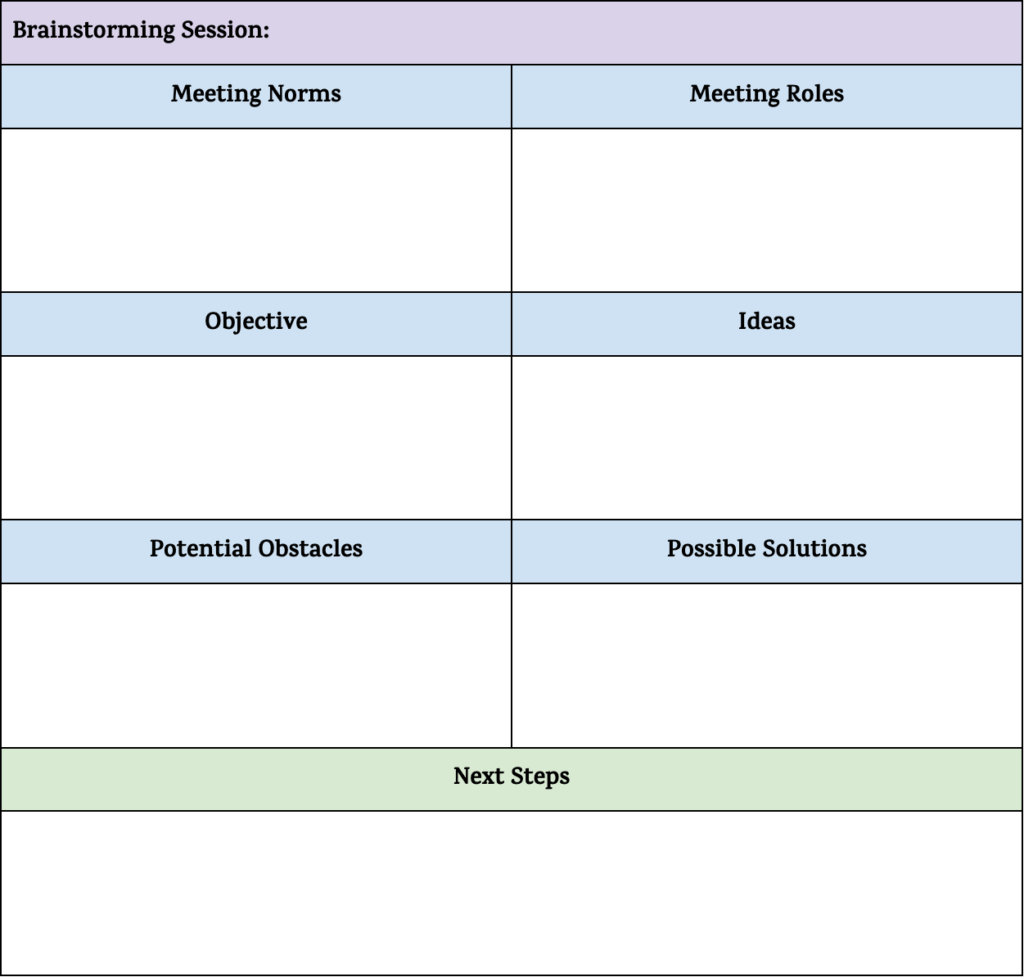Brainstorming sessions are an integral part of developing solutions to any number of problems. They are also a great opportunity for new, creative ideas that lead to growth. But as the “storm” part indicates, they can be rather messy! Educators are passionate about their work with students and their families and can have vastly differing opinions on how to best serve them. So how do we make the most of a brainstorming session, which when effective, can lead to some of the best actionable goals? Below is a blank brainstorming agenda template you can use for any size group, as well as an explanation for each section.

Brainstorming Session
Give your session a title. This could be something that reveals the basic objective or problem you’re trying to solve; it can also be a general topic if you’re just starting out. Maybe student attendance is becoming an issue, and you are looking to gather some initial thoughts and ideas. Or, perhaps your district is looking for a new literacy program. Keeping this part short and sweet will not only get session attendees to start thinking about the overall topic; it will also allow for a more organic (and less restrictive) flow of ideas.
Meeting Norms
Just as educators need to develop a healthy, collaborative classroom culture, meetings with faculty should have norms that everyone agrees to follow. This may be a list you create together at the beginning of the school year, and is then carried through to every meeting. It can also be tailored to one particular brainstorming session. In any case, meeting norms should be decided upon together, with input from all stakeholders. They allow for vulnerability, which in a brainstorming session is especially important. Great ideas come from freedom rather than limitation.
Meeting Roles
You may decide that you want to assign roles (or have people volunteer). This can cut down on the chaos that may sometimes ensue in a less structured meeting environment. A facilitator can ensure that all ideas are heard. A timekeeper can help everyone stay on track, and a recorder can make sure to capture everything in the template for use during and after the session. This is especially important if attendees break into smaller groups, jot down ideas on chart paper, etc.
Objective
The objective of the brainstorming session should be decided ahead of time. It’s a problem that needs addressing or an area for improvement or growth. For example, if the problem is student attendance, the objective could be “to increase student attendance.” If your building is looking for more family engagement, your objective could be as general as “to improve family engagement” or as specific as “to restructure our yearly Open House event to increase family engagement.” Your objective is, simply put, a goal you wish to achieve.
Ideas
Here’s where it can get messy. Most likely, attendees will have a lot of ideas. This is great! But, they may disagree with one another and/or jump in with potential obstacles. Here’s where the facilitator comes in. Let attendees know that all ideas will be recorded first, before a discussion of any possible problems. Individuals can jot down their objections for later if they’re afraid they will forget. (You may also want to include this in your meeting norms.)
So often, people are afraid to share ideas that they haven’t completely worked through, but true openness is what you want in a brainstorming session. Allowing everyone the freedom of contributing without being immediately shut down is conducive to a more genuine flow of ideas. Then, you may decide to narrow down your list before moving to the next step. Do you see patterns? Repetition? Are most attendees nodding in agreement to the same few things? This is where you want to focus your energy.
Potential Obstacles
While the facilitator can help keep this part from turning into an opportunity to just complain, contrarianism might not be such a bad thing here. Potential obstacles must be identified so that they can also be thought through. For example, someone who is a classroom teacher might not think of how a particular action would appeal to the Board of Ed. And an administrator may not know how a new policy would play out in the classroom setting. All voices don’t need to agree, but they need to be heard.
Possible Solutions
Now that ideas and potential obstacles have been shared, discussed, and recorded, it’s time to think about solutions. Which solutions are realistic? Are they short-term? Long-term? Is there permission to be granted? And from whom? Are there any district policies that need to be considered? During this phase, ideas may be narrowed down further, which is all part of the process.
Next Steps
This is where the magic happens. Brilliant ideas do no good without action! Decide as a group what the next steps should be, and who can/will do what. Some things may need to be delegated to an administrator. Maybe more information needs to be gathered from additional faculty members. You may decide a continuation of this particular session is warranted.
Your group might not get through all of these steps in one session. Time may be a rare and precious commodity in education, but hearing ideas, developing solutions, and taking action are all necessary for accomplishing goals.






